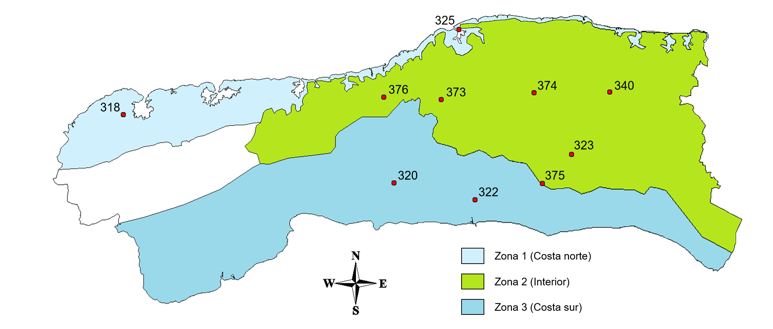Verification of the numerical forecast of the WRF model for Havana, Artemisa and Mayabeque. Study of cases
Main Article Content
Abstract
A verification of the numerical weather forecast obtained with the WRF model was carried out for the provinces of La Habana, Artemisa and Mayabeque. The analysis was performed for three case studies that comprise different types of synoptic scale or mesoscale phenomena that affected the study region. For the simulations, two nested domains of 12 and 4 km of spatial resolution were used, selecting for verification the 4 km, and three different combinations of convection and microphysics parameterizations were used. The data of observations from the ten meteorological stations in the region were taken as a comparison standard, corresponding to the variables to mean sea level pressure, air temperature, wind speed and relative humidity. The cell-point verification methodology was used, calculating statistics to characterize the forecasting ability with said model. The meteorological stations were grouped into three regions for the differentiated study of forecast errors. It is concluded that the best simulated variable by the model is atmospheric pressure and that wind speed is the worst simulated, with a mean relative error between 14 and 621 %. The stations located on the southern coast have, in most cases, the largest forecast errors.
Downloads
Article Details

This work is licensed under a Creative Commons Attribution-NonCommercial 4.0 International License.
Those authors who have publications with this journal accept the following terms of the License Attribution-NonCommercial 4.0 International (CC BY-NC 4.0):
You are free to:
- Share — copy and redistribute the material in any medium or format
- Adapt — remix, transform, and build upon the material
The licensor cannot revoke these freedoms as long as you follow the license terms.
Under the following terms:
- Attribution — You must give appropriate credit, provide a link to the license, and indicate if changes were made. You may do so in any reasonable manner, but not in any way that suggests the licensor endorses you or your use.
- NonCommercial — You may not use the material for commercial purposes.
- No additional restrictions — You may not apply legal terms or technological measures that legally restrict others from doing anything the license permits.
The journal is not responsible for the opinions and concepts expressed in the works, they are the sole responsibility of the authors. The Editor, with the assistance of the Editorial Committee, reserves the right to suggest or request advisable or necessary modifications. They are accepted to publish original scientific papers, research results of interest that have not been published or sent to another journal for the same purpose.
The mention of trademarks of equipment, instruments or specific materials is for identification purposes, and there is no promotional commitment in relation to them, neither by the authors nor by the publisher.
References
Díaz, Y., & Díaz, O. (2010). Evaluación del pronóstico numérico del tiempo a corto plazo para Cuba con el modelo de mesoescala MM5V3. Trabajo de Diploma, Universidad de La Habana, InSTEC, La Habana.
Félix, J., González Ramírez, C. M., Hernández, J. F., & González Jardines, P. M. (2017). Estructura interna de las tormentas que generan tiempo severo a partir del modelo WRF-ARW. Tesis de Diploma, Universidad de La Habana, InSTEC, La Habana.
Fuentes, T., González Ramírez, C. M., González Jardines, P. M., & Fernández, J. C. (2019). Análisis de la formación y evolución de nubes convectivas mediante el Índice Gálvez Davison a partir del WRF. Tesis de Diploma, Universidad de La Habana, InSTEC, La Habana.
González Ramírez, C. M., González Jardines, P. M., & Hernández, J. F. (2017). Evaluación de la afectación del huracán Irma, utilizando la modelación numérica en las provincias de Artemisa y Mayabeque. Revista Cubana de Meteorología, 23(3), 363-377.
Jolliffe, I. T., & Stephenson, D. B. (Eds.). (2003). Forecast Verification. A Practitioner´s Guide in Atmospheric Science. Wiley.
Moreno, S., González, C. M., & Ferrer, A. L. (2017). Verificación del pronóstico cuantitativo de la precipitación del modelo WRF para las provincias Artemisa, Mayabeque y La Habana. Revista Cubana de Meteorología, 23(2), 148-163.
Moya, A., & Ortega, J. M. (2015). Aplicación del modelo meteorológico WRF para el pronóstico de precipitaciones en período lluvioso de Cuba, 2014. Apunt. Cienc. Soc., 15(1), 135-145. doi:http://dx.doi.org/10.18259/acs.2015021
Pérez, A., Mitrani, I., & Díaz, O. (2014). Sistema de Predicción Numérica Océano-Atmósfera para la República de Cuba. Informe de Resultado Científico, Insituto de Meteorología, Centro de Física de la Atmósfera.
Sánchez, E. O., Álvarez, L., & Ferrer, A. L. (2018). Evaluación del pronóstico a mediano plazo de la componente atmosférica del SPNOA con datos de estaciones meteorológicas del INSMET. Tesis de Diploma, Universidad de La Habana, InSTEC, La Habana.
Sierra, M., Borrajero, I., Ferrer, A. L., Morfa, Y., Morejón, Y., & Hinojosa, M. (2017). Estudios de sensibilidad del SisPI a cambios de la PBL, la cantidad de niveles verticales y, las parametrizaciones de microfísica y cúmulos, a muy alta resolución. Proyecto: "Sistema de Predicción a muy corto plazo basado en el Acoplamiento de Modelos de Alta Resolución y Asimilación de Datos II", Instituto de Meteorología, Centro de Física de la Atmósfera.
Sierra, M., Ferrer, A. L., Hernández, R., González, Y., Cruz, R. C., Borrajero, I., & Rodríguez, C. F. (2014). Sistema automático de predicción a mesoescala de cuatro ciclos diarios. Proyecto: "Sistema de Predicción a muy corto plazo basado en el Acoplamiento de Modelos de Alta Resolución y Asimilación de Datos", Instituto de Meteorología, Centro de Física de la Atmósfera.

